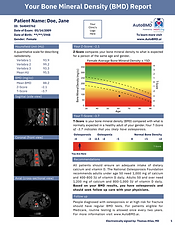Opportunistic Osteoporosis Screening with
With AutoBMD AI
CT Add-on Automated Bone Mineral Density Report
TM

The First FDA-Approved, AI-Powered, Cloud-Based, Opportunistic Bone Mineral Density (BMD) Measurement Test that Works on any CT Scan.
AutoBMD™ enables your imaging center to take advantage of CT scans ordered for other purposes, and create opportunistic osteoporosis screening reports which are reimbursed by Medicare and private payers.
How To Order AutoBMD™
AutoBMD™ for Diagnostic Imaging Centers
Step 1
Set up your HeartLung Provider account in 5 minutes
Step 2
Install HeartLung Gateway to send scans to AutoBMD™ cloud automatically
Step 3
Access AutoBMD™ reports on your Provider Portal and opt in to automatically forward reports to patients
Simple & Easy Workflow Integration
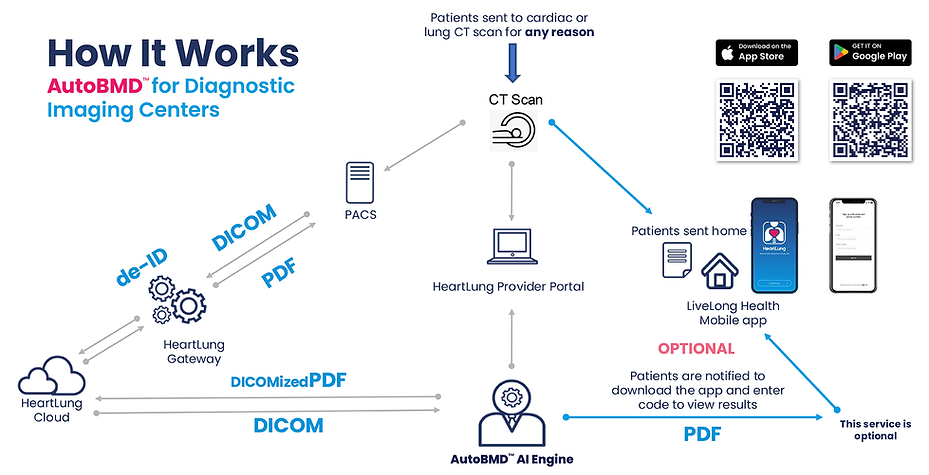


![Pattern 5 [Converted]-01_edited.jpg](https://static.wixstatic.com/media/51c62d_1c741db3efd74caa82a5345455f5218b~mv2.jpg/v1/fill/w_143,h_105,al_c,q_80,usm_0.66_1.00_0.01,blur_2,enc_avif,quality_auto/51c62d_1c741db3efd74caa82a5345455f5218b~mv2.jpg)
.png)
WHY OFFER AUTOBMD
Meet the Growing Need
Women
Over 30M women over 65 should have a bone density scan every other year, but less than 7% are getting one.
Elderly
Osteoporisis is increasingly being recognized as public health concern in the aging population.

REPORT FEATURES
How AutoBMD™ Works
This report is created using HeartLung's FDA approved and cloud-based AutoBMD™ that helps doctors quickly identify patients who are having accelerated bone loss and are at risk of cracks, compressions, or fractures in their skeletal body, but are unaware of their serious condition.
This AI-powered tool automatically extracts valuable information about bone health from any CT scan of a patient's chest or abdomen, done for any reason. Therefore, it saves patients extra radiation and extra screening cost.
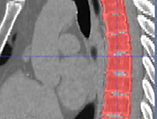
1
Automatically detect the vertebral column
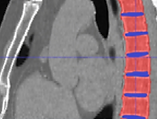
2
Disk segmentation and labeling vertebral bones
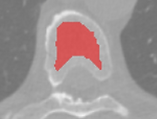
3
Detecting the trabecular component of the vertebral bones as the region of interest
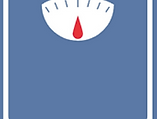
4
Calculating BMD using Housfield Units with built-in calibration factor (no phantom required)
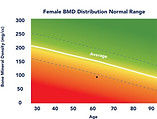
5
Reporting T-Score and Z-Score, along with axial, coronal, and sagittal views of the ROI
An In-Depth Look
Z-Score
Z-score is your bone density compared to a healthy person of the same age and gender. This represents how far off your score is (measured in the number of standard deviations) from the average score of healthy people of similar age.
Z-scores of -2.0 or lower are classified as low BMD for chronological age and those above -2.0 classified as within the expected range.

T-Score
T-score is your bone density compared with what is normally expected in a healthy young adult of your sex. People with normal bone density have a T-score between +1 and -1.

Download a sample
Sample report
Our Approach Is Opportunistic Bone Mineral Density
It is superior to DEXA and regular QCT scans
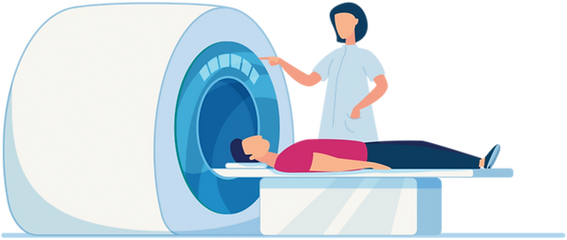
No Extra Scan
No Extra Radiation
No Extra Trip To Radiology Clinics
Extra Value for Patients
Extra Revenue for Clinics
AutoBMD™ enables your doctor to take advantage of CT scans ordered for other purposes and measure your bone density.
OUR APPROACH
AutoBMD™ AI takes advantage
of existing CT scans
AutoBMD reports Z-score and T-score similar to DEXA scans, and detects osteopenia and osteoporosis for prevention of future bone fractures.

Low Bone Density
It is a condition that causes bone mineral density to decline, increasing the risk of fractures.

How It's Detected
Bone density is usually measured using a DEXA scan or quantitative CT scan (QCT)
Traditional
DEXA Report

AutoBMD™
Report

Scientific Publications
Backed by Research
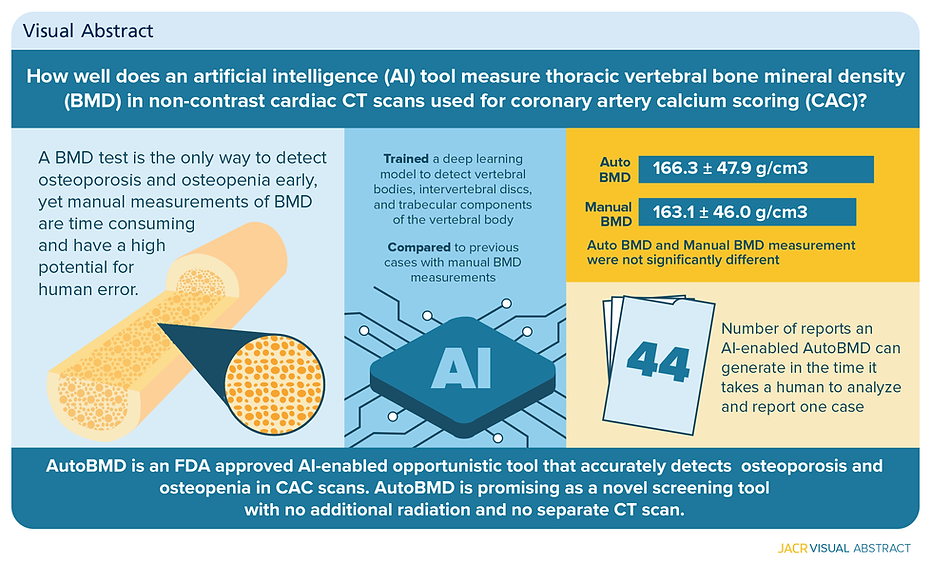
Legend:
• Journal of American College of Radiology 2024 Apr;21(4):624-632
Take Home Points
More Scientific Publications
Backed by Research
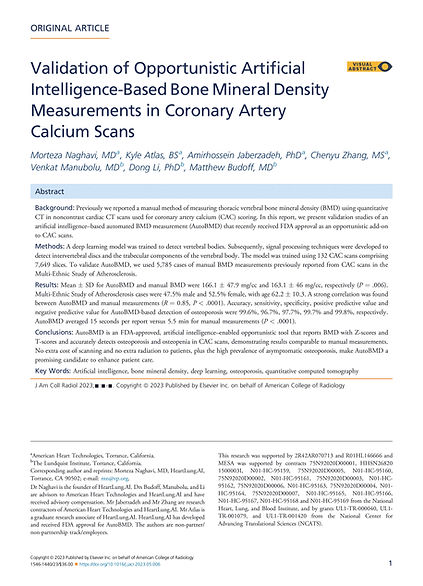
Citation:
• Naghavi M, Atlas K, Jaberzadeh A, Zhang C, Manubolu V, Li D, Budoff M. Validation of Opportunistic Artificial Intelligence-Based Bone Mineral Density Measurements in Coronary Artery Calcium Scans. J Am Coll Radiol. 2024 Apr;21(4):624-632.

Citation:
• Naghavi M, De Oliveira I, Mao SS, Jaberzadeh A, Montoya J, Zhang C, Atlas K, Manubolu V, Montes M, Li D, Atlas T, Reeves A, Henschke C, Yankelevitz D, Budoff M. Opportunistic AI-enabled automated bone mineral density measurements in lung cancer screening and coronary calcium scoring CT scans are equivalent. Eur J Radiol Open. 2023 May 13;10:100492.
Legend:
• (a) T-score correlation plot of AutoBMD software and manual bone mineral density (BMD) (R2 ¼ 0.85).
• (b) Z-score correlation plot of AutoBMD software and manual BMD (R2 ¼ 0.80).
Legend:
• AutoBMD results obtained for the average BMD for vertebrae T7 to T9 in 165 corresponding lung and cardiac CT scans. For all vertebrae, n = 165, with the exception of T9 for cardiac for which n = 150.
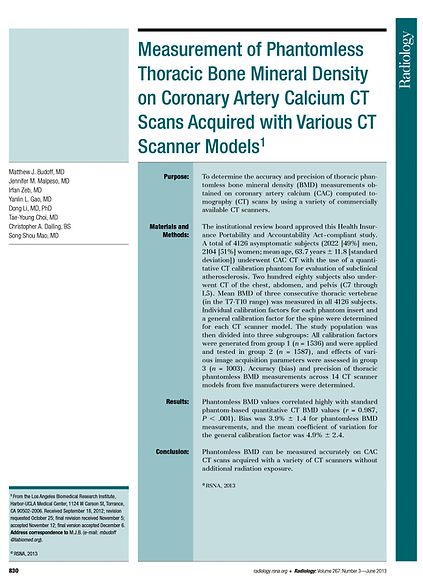
Citation:
• Budoff MJ, Malpeso JM, Zeb I, Gao YL, Li D, Choi TY, Dailing CA, Mao SS. Measurement of phantomless thoracic bone mineral density on coronary artery calcium CT scans acquired with various CT scanner models. Radiology. 2013 Jun;267(3):830-6.

Citation:
• Budoff MJ, Hamirani YS, Gao YL, Ismaeel H, Flores FR, Child J, Carson S, Nee JN, Mao S. Measurement of thoracic bone mineral density with quantitative CT. Radiology. 2010 Nov;257(2):434-40.
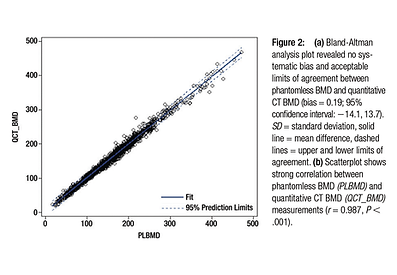
Legend:
• Linear graphs illustrate comparison of lumbar (y) and thoracic (x) quantitative CT measurements. BMDs measured with lumbar and thoracic quantitative CT were highly correlated. BMDs were systematically higher with thoracic CT in (a) 322 male and (b) 322 female subjects.
Legend:
• A significant positive correlation was found between phantomless and quantitative CT BMD measurements (r = 0.98, P , .001).
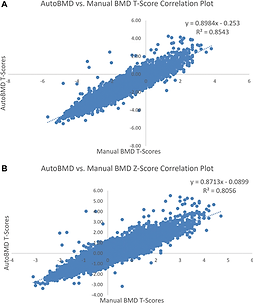
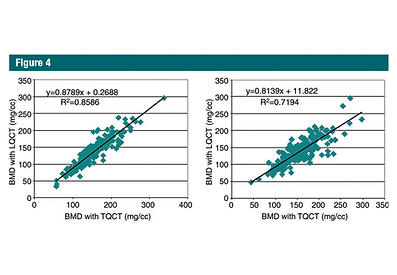
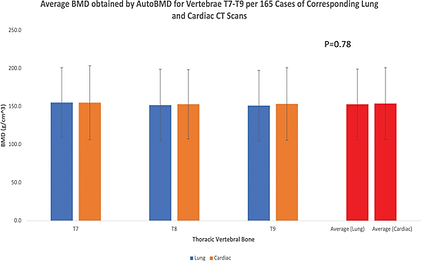

Citation:
• Budoff MJ, Khairallah W, Li D, Gao YL, Ismaeel H, Flores F, Child J, Carson S, Mao SS. Trabecular bone mineral density measurement using thoracic and lumbar quantitative computed tomography. Acad Radiol. 2012 Feb;19(2):179-83.

Citation:
• Song Shou Mao, Dong Li, Younus Saleem Syed, Yanlin Gao, Yanting Luo, Ferdinand Flores, Janis Child, MacKenzie Cervantes, Kamyar Kalantar-Zadeh, Matthew J. Budoff, Thoracic Quantitative Computed Tomography (QCT) Can Sensitively Monitor Bone Mineral Metabolism: Comparison of Thoracic QCT vs Lumbar QCT and Dual-energy X-ray Absorptiometry in Detection of Age-relative Change in Bone Mineral Density, Academic Radiology, Volume 24, Issue 12, 2017, Pages 1582-1587, ISSN 1076-6332.
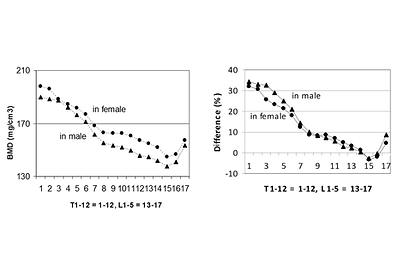
Legend:
• Comparison of QCT and DXA in the age-related annual loss rate of bone in women (left panel) and men (right panel). DXA, dualenergy X-ray absorptiometry; QCT, quantitative computed tomography.
Legend:
• Bone mineral density (BMD) value of 17 vertebrae by the QCT technique.
• The percent difference between L1–3 and 17 individual measurements.
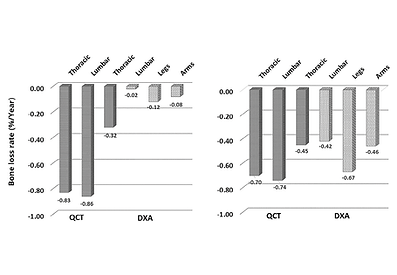
Direct and Indirect Revenue
Opportunities for Providers


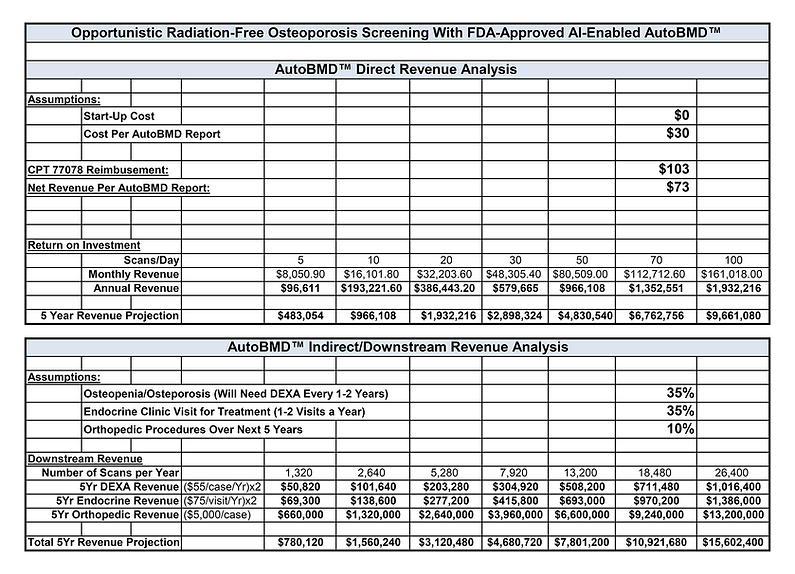
![Pattern 5 [Converted]-01.png](https://static.wixstatic.com/media/51c62d_44f38c257d614130ace0f56455e9be12~mv2.png/v1/fill/w_49,h_36,al_c,q_85,usm_0.66_1.00_0.01,blur_2,enc_avif,quality_auto/51c62d_44f38c257d614130ace0f56455e9be12~mv2.png)
TM
Benefits of AutoBMD AI
Opportunistic Revenue Generator
AutoBMD™ enables your imaging center to add a BMD report to CT scans ordered for other purposes with consent from patients and referring physicians.
No Capital Investment Needed
Any diagnostic imaging center from anywhere in the world can sign up and start adding AutoBMD™ report to any CT scans of the chest and abdomen.
Simple and Easy Workflow Integration
Your practice can install the HeartLung gateway and receive AutoBMD™ AI reports directly in your PACS. Your patients can access the report from HeartLung’s web portal and mobile app.
Rapid AI Turnaround Within Minutes
Receive rapid results within minutes of sending your scan to AutoBMD™ AI cloud. No training or learning curve is needed and no calibration phantom.
AutoBMD™ is reimbursed under CPT 77078
No training or learning curve is needed, and no calibration phantom
No hardware or CapEx is required, your practice can start adding reports immediately
Your patients can access the report from AutoBMD's web portal and mobile app
Osteoporosis screening is covered under USPSTF and is repeated every 5 years, therefore increasing patient engagement
Frequently Asked Questions
Provider Q&A
Is AutoBMD™ reimbursed? If yes, what CPT code?
Yes, AutoBMD™ AI is reimbursed by Medicare and private payers as part of the osteoporosis screening mandate by US Preventative Task Force Services (CPT 77078). AutoBMD™ report is based on qCT (Quantitative CT) and uses a 3D bone density analysis that is superior to DEXA which is 2D. The only advantage of DEXA over qCT is lower radiation exposure; however, in the case of AutoBMD™, the radiation is ZERO because it is an opportunistic screening as an add-on to CT scans ordered for other reasons.
How does my PACS connect to AutoBMD™ AI cloud?
Your PACS can easily connect to AutoBMD™ cloud through a direct link using your unique AE title generated by HeartLung; or via a HeartLung Gateway installed and no hardware installation is required. The scanned CT image is sent from your PACS to AutoBMD™ AI cloud where the report is created and sent back to you and is also viewable on HeartLung’s Provider & Patient Portal. https://provider.heartlung.ai
Do I need a physician’s order to add an AutoBMD™ AI report to a thoracic or abdominal CT scan?
Opportunistic osteoporosis screening may not require a physician’s order for reimbursement purposes. However, this may vary by the payer and the state law. Depending on the state, certain restrictions may apply to self-referring screening. Because AutoBMD™ poses no radiation risk or procedural issues, this may be lesser of an issue in those states. Nonetheless, because referring physicians are responsible for treating patients with osteoporosis, we strongly recommend informing and engaging all referring physicians.
Can AutoBMD™ be done on patients who have done DEXA in the past?
Yes, it can but for reimbursement purposes certain restriction may apply. If DEXA was less than 2 years ago, chances are the payers may not cover an additional bone density report. As stated previously, because there is no additional radiation to patient, informing them of their options is recommended.
Which image series should I send to AutoBMD™ AI Cloud?
Only send one axial series to AutoBMD™ AI cloud. For example, the axial series used for coronary artery calcium scoring or lung cancer screening would work. The AutoBMD™ AI module operates based on intensity (Hounsfield Units); therefore, please send images generated using the standard convolution kernel without any modifications or reconstructions.
How do I start a free trial?
Simply create an account at https://provider.heartlung.ai and send your first set of DICOM images using the unique AE title that our system generates for your center. You will be contacted within 24 hours for verification and testing the setup. Reports are sent back to PACS in less than 5 minutes as a DICOMized PDF, helping providers detect osteoporosis or osteopenia before the patient even leaves the office. The trial includes 10 free cases, and reports are Medicare-reimbursable. No hardware required. No IT complexity. Just turn on the AutoBMD™ pipeline and start identifying at-risk patients using scans you’re already doing.








